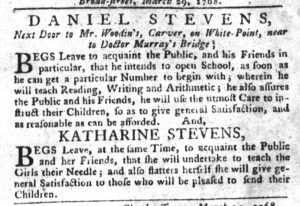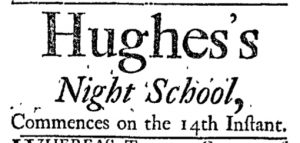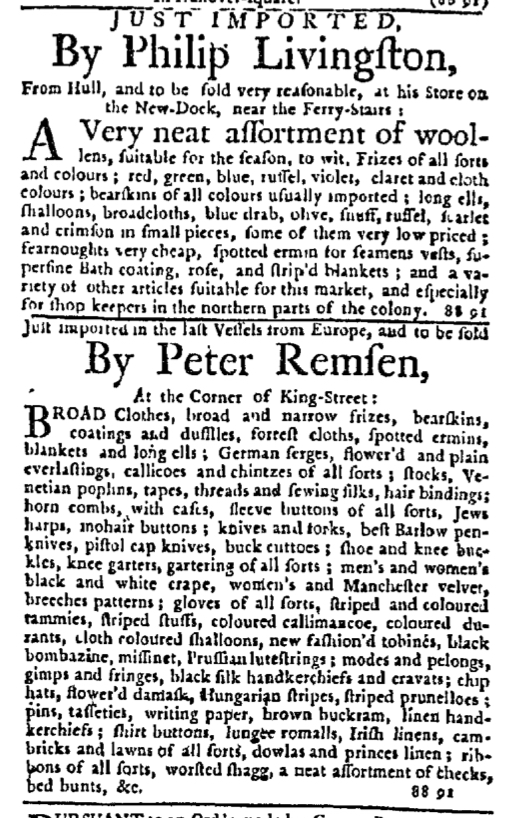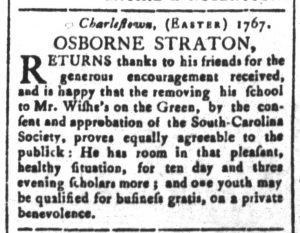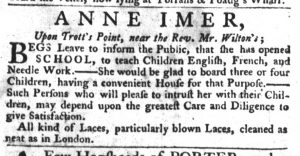GUEST CURATOR: Mary Bohane
What was advertised in a colonial American newspaper 250 years ago today?

“Alexander Findlay & James Seyour, A.M. DESIGN TO OPEN SCHOOL.”
Alexander Findlay and James Seymour advertised a school where they taught “BRANCHES of LITERATURE” as well as “several PARTS of the MATHEMATICKS.” Today it seems hard to imagine a world without public schools considering that most students attend public schools rather than private ones. However, throughout the colonial period and into the nineteenth century, private schools, like the one featured in this advertisement, were often the only option for education outside the home in many places.
According to Robert A. Peterson, education began at the home, typically as the responsibility of the mother, and, as the children grew older, became the father’s task. In Learning to Read and Write in Colonial America, E. Jennifer Monaghan explains that “religious motives underlay reading instruction in colonial America, while secular motives led to writing instruction.” The most commonly read books were the Bible, a primer, and a hornbook. As children in southern colonies grew older, their schooling prepared them for their eventual roles in plantation life. Boys advanced further in subjects such as math, Greek, Latin, science, and navigation. Girls learned the duties of the mistress of the plantation, such as basic arithmetic to handle household expenses.
Today many people argue that without public schools the job of educating future generations would simply not get done, but colonists did not have the same access to widespread public education that Americans now take for granted.
**********
ADDITIONAL COMMENTARY: Carl Robert Keyes
Although Alexander Findlay and James Seymour sought children and youth as students at their school “in the lower End of Broughton-Street” in Savannah, they also suggested that they provided adult education as well, at least when it came to writing. As Mary notes, they taught the basics of reading, writing, and arithmetic as well as some more advanced subjects, promising that their methods would “do all possible justice to those who will please to commit their children to their care.” However, they concluded their advertisement with a nota benethat reiterated that they offered writing instruction: “They also design to teach Writing at the same place between the hours of twelve and one.” Assuming that their young pupils took a break from their studies at midday, Findlay and Seymour had an opportunity to teach adults who wished to learn or further develop a particular skill without enrolling for the entire curriculum.
Even though today most people link the ability to read and the ability to write because they have been taught simultaneously or in quick succession in elementary schools, that was not the case in the colonial period. Reading and writing were considered different skills utilized for different purposes. Learning to read granted colonists access to the Bible and other devotional literature, whereas learning to write (and do arithmetic) opened up the world of commerce to them. Accordingly, colonists considered reading the more vital skill. Many of those who perused the Georgia Gazettemay well have been able to read Findlay and Seymour’s advertisement and the other content yet did not possess the ability to make notes in the margins, write a note asking for more information, or otherwise use quill and ink in their daily lives. Like the Latin and Greek that the schoolmasters proposed to teach, writing was not a necessity in colonial society, but it was certainly useful for those who acquired the skill. For adults who had not previously learned to write as part of their education, Findlay and Seymour offered a chance to obtain that skill in brief lessons without pursuing the rest of the relatively extensive curriculum at their day school.

